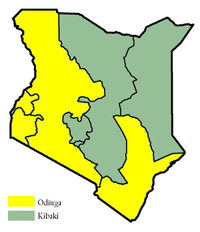Kenyan general election, 2007
|
|
||||||||||||||||
|---|---|---|---|---|---|---|---|---|---|---|---|---|---|---|---|---|
|
||||||||||||||||
|
||||||||||||||||

Presidential election results map. Green denotes provinces won by Kibaki, and Yellow denotes those won by Odinga.
|
||||||||||||||||
|
||||||||||||||||
General elections were held in Kenya on 27 December 2007, electing the President, National Assembly and local councils.
The presidential elections were a two-horse race between incumbent Mwai Kibaki, running on a Party of National Unity (PNU) ticket and Raila Odinga, leader of the Orange Democratic Movement (ODM). They were strongly marked by tribal hostility, with Kibaki a member of the traditionally dominant Kikuyu ethnic group, gaining much support amongst the Kikuyu and neighbouring groups in central Kenya, including the Embu and Meru. Odinga, as a member of the Luo ethnic group, succeeded in creating a wider base by building a coalition with regional leaders from the Luhya in Western Kenya, Kalenjin from the Rift Valley and Muslim leaders from the Coast Province. Kibaki was declared the winner with 46% of the vote, and was sworn in at State House on 30 December. However, opposition leader Raila Odinga also claimed victory, and civil unrest broke out resulting in the deaths of several hundred people and the displacement of up to 600,000. This was ended by the National Accord and Reconciliation Act, which led to Odinga being appointed as Prime Minister.
...
Wikipedia


